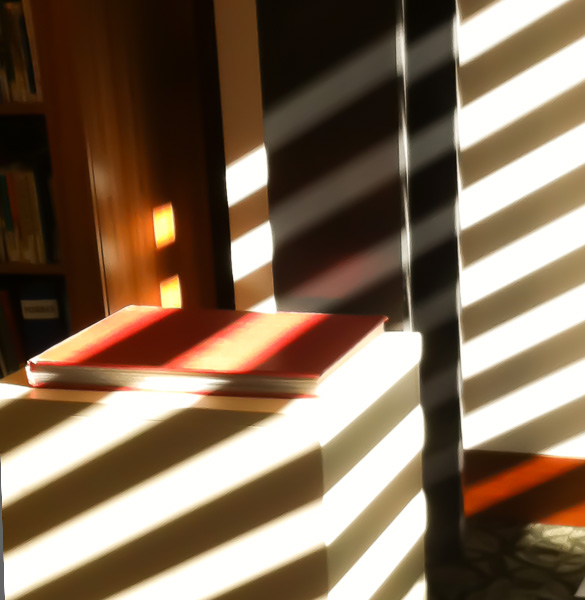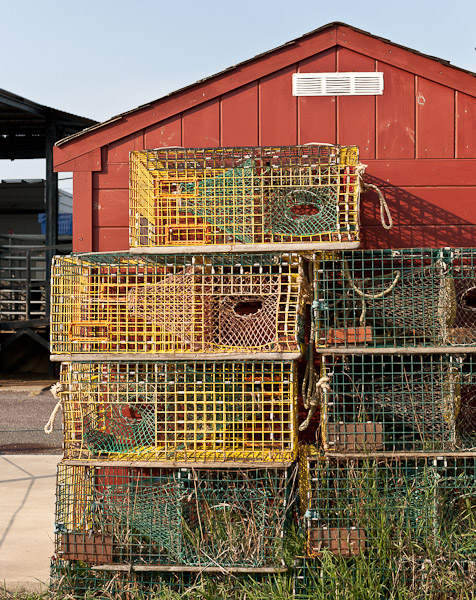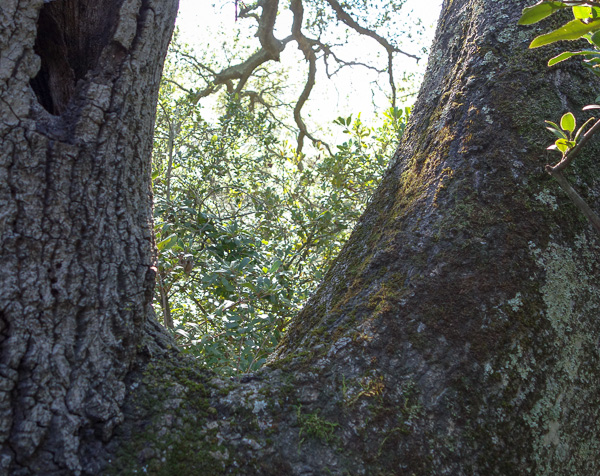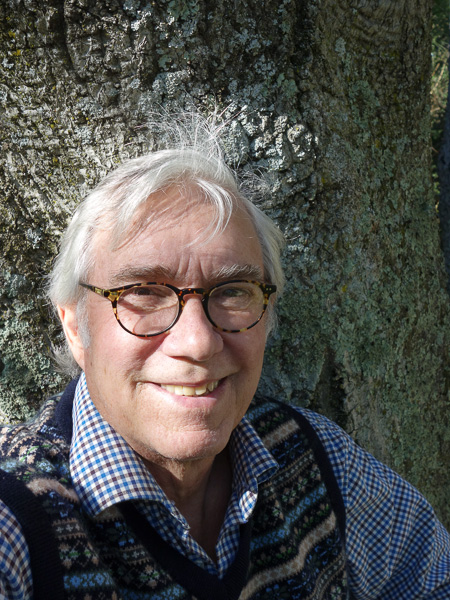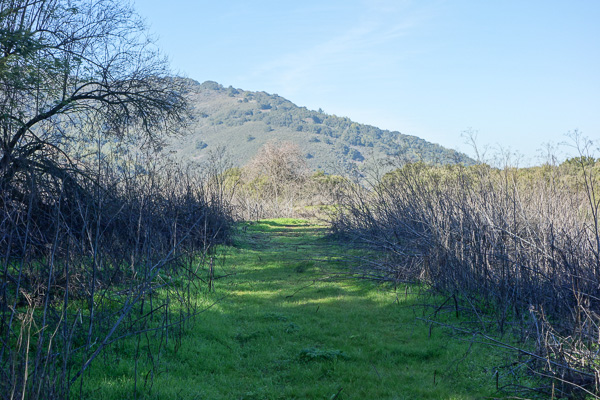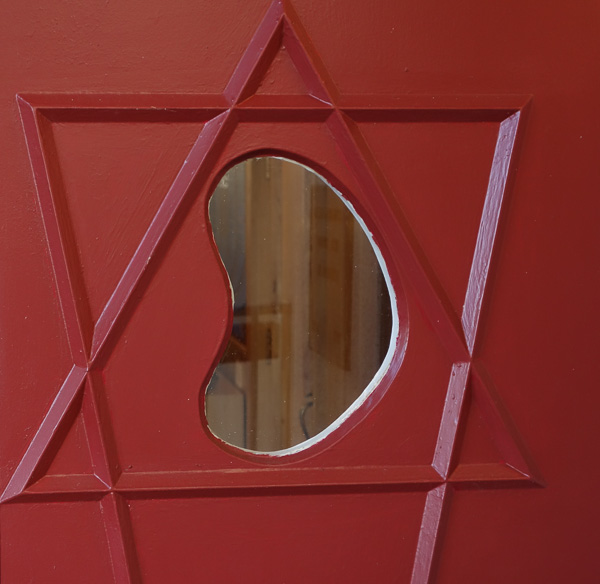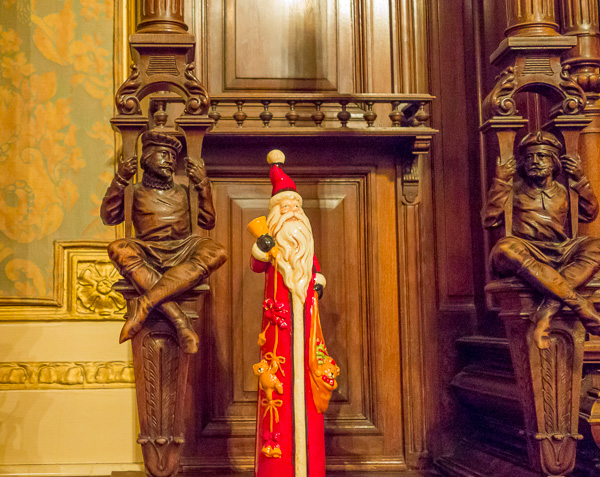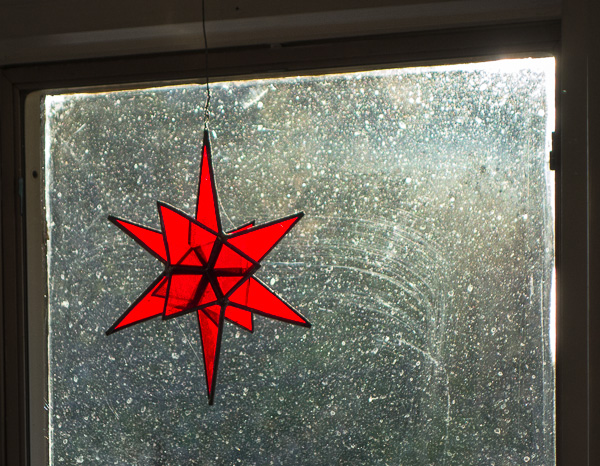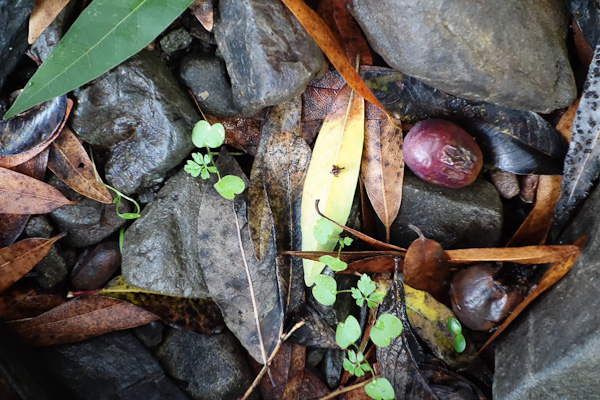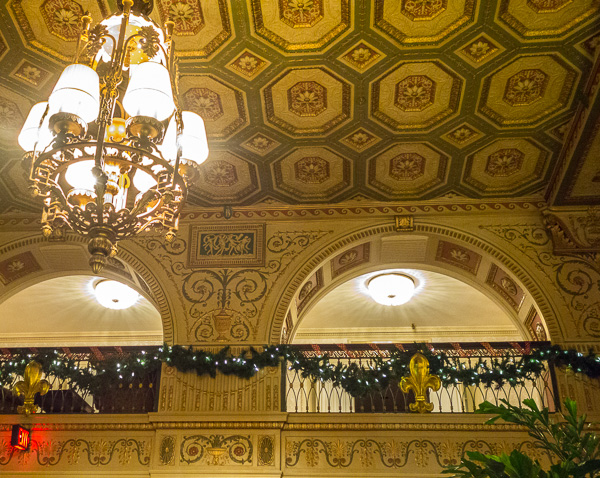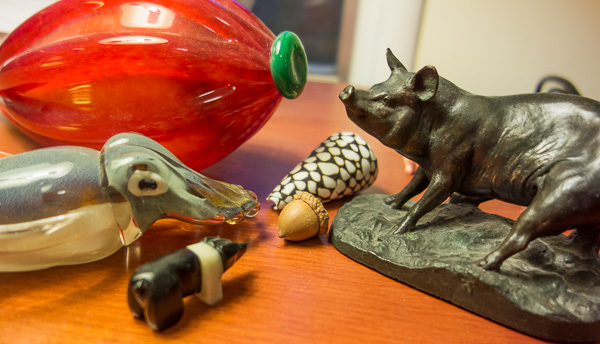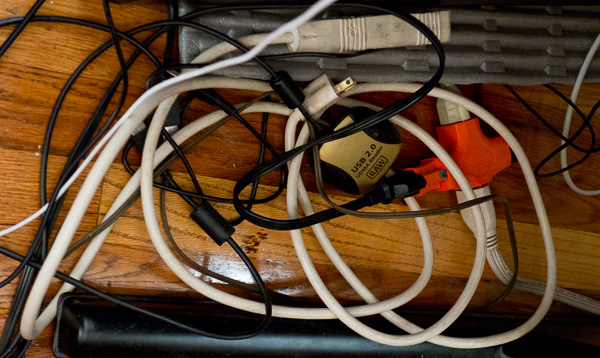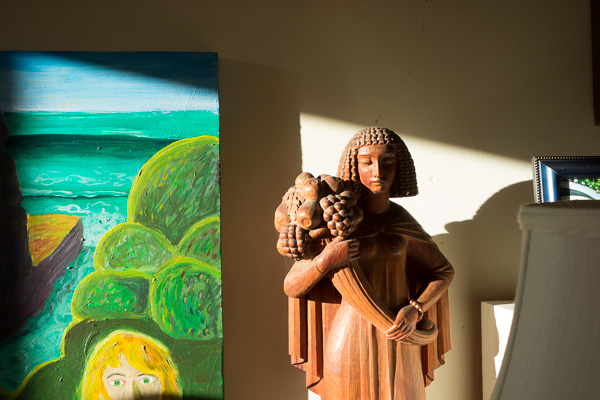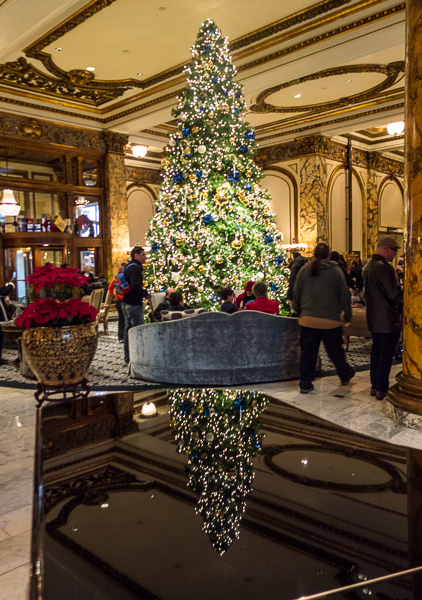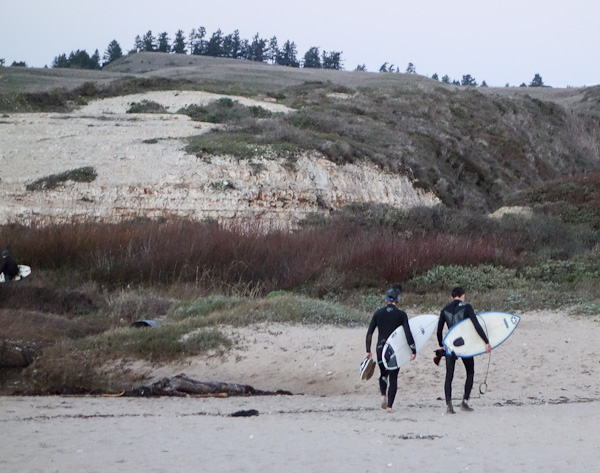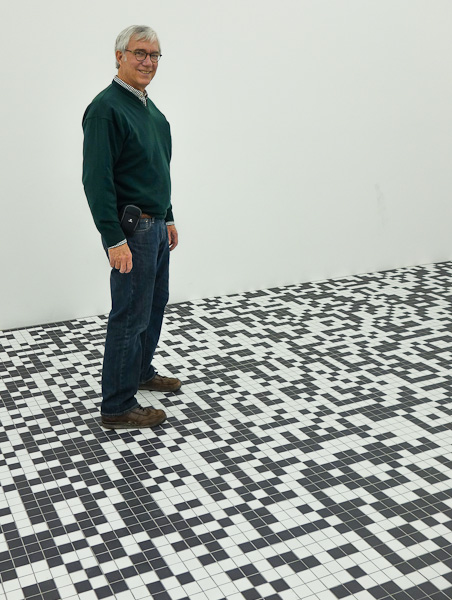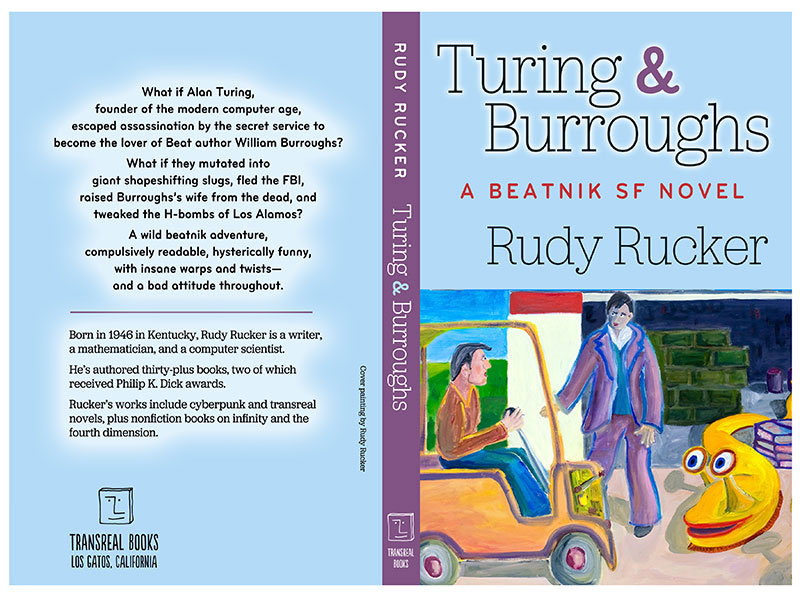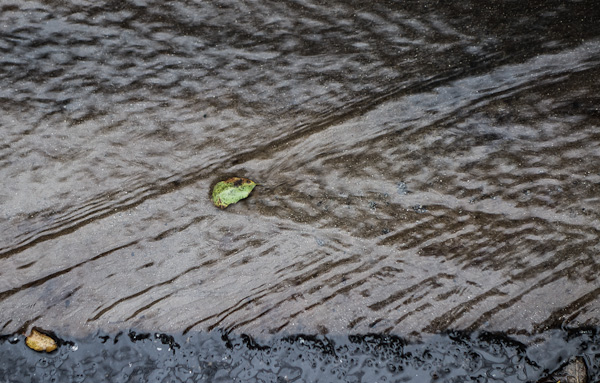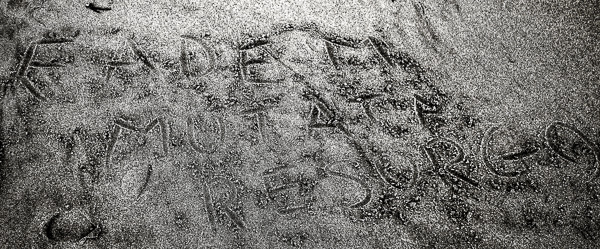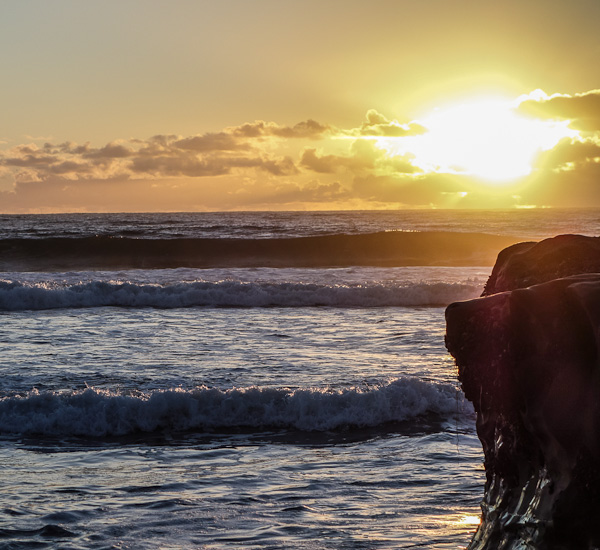[I'll be staging a new Borderlands art show starting Friday, January 17, 2014, in conjunction with a book release party for my novel THE BIG AHA. More info to come. The rest of the material in this old post is about the show in January, 2013.]
I’m venturing forth from my office this weekend to do some promo at Borderlands Books at 866 Valencia St. in San Francisco.

View of my home office from my desk chair. Click for a larger version of the image.
I’ll be hanging a show of my paintings in the Borderlands Books café with a reception on Friday, Jan 11, 5-7 pm. And I’ll give a reading and Q&A session for my novel Turing & Burroughs: A Beatnik SF Novel on Saturday, Jan 12, at 3 pm—you can visit with the paintings then as well. The show is scheduled to run until March 7, 2013.
Added Jan 13, 2013. I made a podcast of the first 20 minutes of my presentation on Turing & Burroughs, I’m describing the book and reading from it. Unfortunately I ran out of memory on my digital recorder, and the podcast stops abuptly at the 20 min mark. But it’s fun for as far is it goes. You can click on the icon below to access the podcast via Rudy Rucker Podcasts.
I number my paintings, and I have an overview image of all my paintings below, showing paintings #1 – #94. The pictures in the show will from the bottom rows, that is, in the range #79 – #94. Further down in today’s post I’ll put in images of the individual pictures that will be in the show, with notes on each picture.
For a limited time, the pictures are on sale at drastically reduced prices—up to 50% off! The current prices of the paintings can always be found on my Paintings page. Several of the paintings in the show have already sold, so do buy early if you want to be sure of getting a given picture at a low sale price.
Note that the Painting page also has a link for buying prints of the pictures, and a link for buying Better Worlds, an art book of the paintings. Better Worlds and a few prints are also available at Borderlands Books.
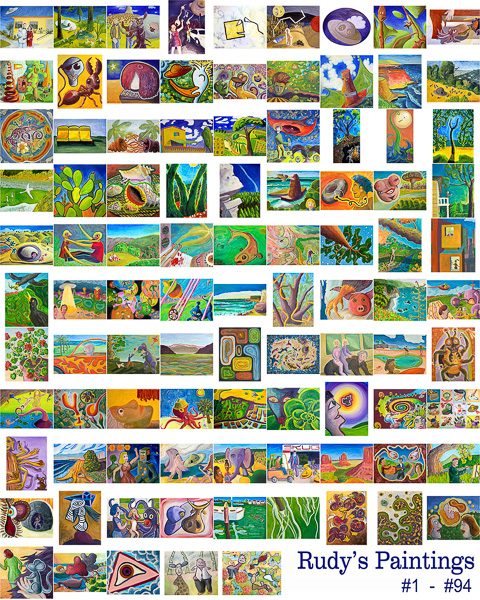
Overview of my paintings. Click for a larger version of the image.
All the pictures I’ll be showing have not been shown before, except for one, Turing and the Skugs, which relates to my Turing & Burroughs novel. This older picture appeared in my last Borderlands Books cafe show, which was in November, 2010.
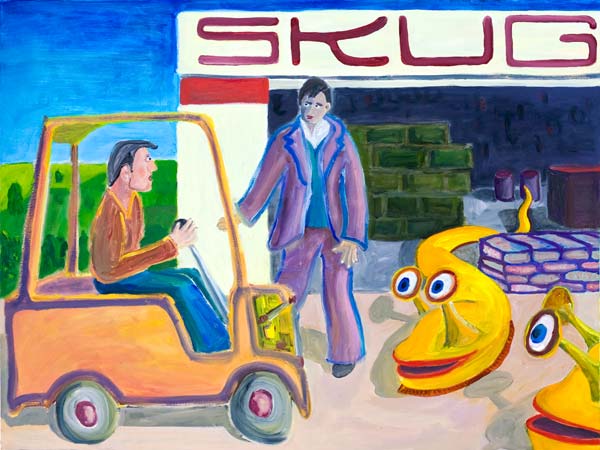
“Turing and the Skugs”, 40″ x 30″ inches, Oct 2010, Oil on canvas.” Click for larger version.
I made Turing and the Skugs while gearing up for my Turing & Burroughs novel involving the computer pioneer Alan Turing, the beatniks, and some shape-shifting beings called skugs. I got the word “skug” from my non-identical twin granddaughters, aged three. When I used visit my son’s house in Berkeley, I always liked to open up his worm farm and study the action with the twins. We found a lot of slugs in there, and we marveled at them. The girls tended to say “skug” rather than “slug,” and I decided I liked the sound of this word so much that I’d use it for some odd beings in my novel. I’m supposing that Turing has carried out some biochemical experiments leading to the creation of the skugs. Here we see Turing outside the Los Gatos Rural Supply Hardware garage, with two skugs backing him up. Alan is meeting a handsome man who may well become his lover. Unless the skugs eat the guy.
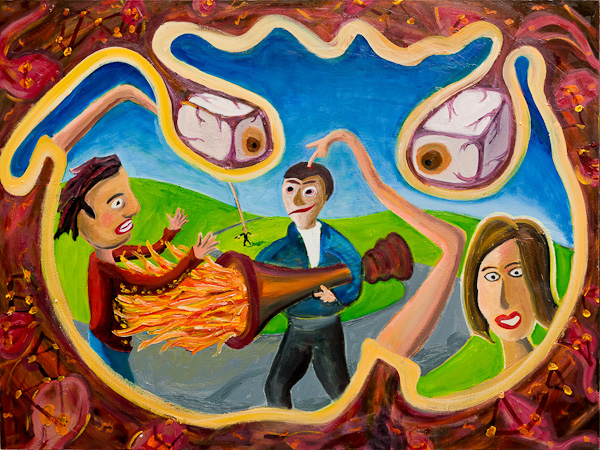
“A Skugger’s Point of View”, 40″ x 30″ inches, January, 2011, Oil on canvas.” Click for larger version.
In A Skugger’s Point of View I wanted to render an extreme first-person point of view…in which we see the dim zone around a person’s actual visual field. The person in question is the Alan Turing character in my novel The Turing Chronicles. He has become a mutant known as a “skugger,” and he has the ability to stretch his limbs like the cartoon character Plastic Man. He’s traveling across the West with two friends, a man and a woman. In this scene, Turing’s cohort is being attacked by secret police, one of whom bears a flame-thrower. Turing is responding by sticking his fingers into their heads, perhaps to kill them, or perhaps to convert them into skuggers as well. We can see Turing’s arms extending from the bottom edge of his visual field. Even though it’s not quite logical, I painted in his eyes as well because they make the composition better
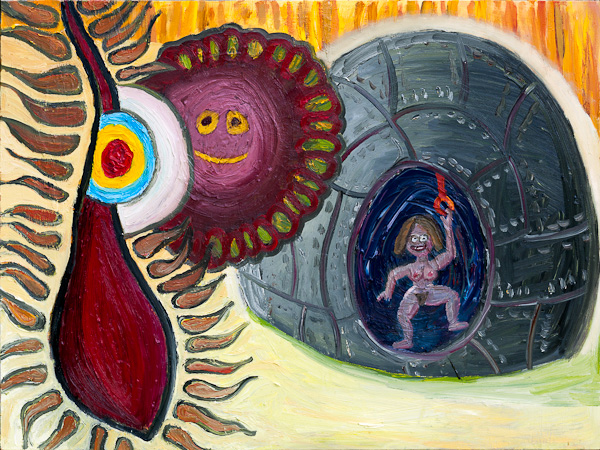
“V-Bomb Blast”, 40″ x 30″ inches, July, 2011, Oil on canvas.” Click for larger version.
This painting has to do with my novel, The Turing Chronicles. In the last chapter, my hero, Alan Turing gets inside a nuclear weapon called a V-bomb. I figured this lies beyond the A-bomb and the H-bomb. Turing is in there tweaking the bomb until the last minute. And due to Turing’s efforts, the bomb explodes in an odd fashion: it makes a fireball that shrinks, rather than growing—and then the bomb explosion tears a hole in space and disappears into another dimension or into another level of reality. The early nuclear devices really were hut-sized metal constructs, as shown on the right. Somehow I ended up putting a naked woman inside the bomb instead of Turing. In the middle we have a kind of sunflower/fireball with a zonked face on it. And on the left, a small explosion-ball disappears into a vaginal rent. The woman seems to be pulling a cord that sets the bomb off in the first place. I like the picture because, as with some of Bruegel’s paintings, it seems to illustrate a detailed parable whose precise meaning is forever a mystery.
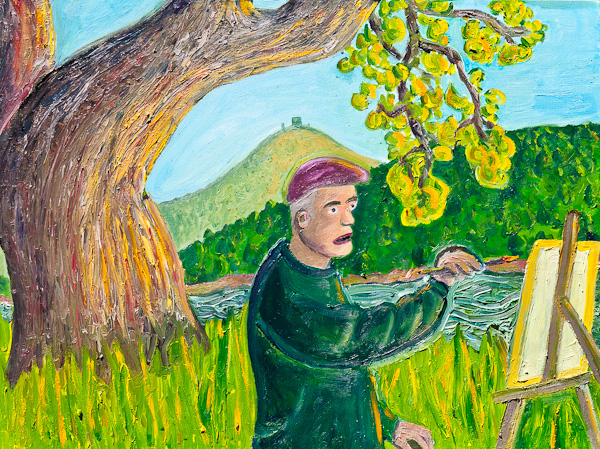
“Painter Near Mt. Umunhum,” 24 x 18 inches, September, 2011, Acrylic on canvas.” Click for larger version.
My painter friend Vernon Head and I were painting en plein air in the Almaden Quicksilver Park south of San Jose near the Guadalupe Reservoir. I was about to get my left hip joint replaced, due to arthritis, but I led Vernon up to a nice oak I admired on a hilltop. I framed Painter Near Mt. Umunhum to include the reservoir, Vernon, the oak, and Mount Umunhum in the background. “Umunhum” is an Ohlone word meaning “home of the hummingbird.” The box on top is a leftover from an Air Force radar station, that’s due to come down…someday. I layered on my paint thicker than usual, using my palette knife to imitate the grooves of the bark on the tree, the waves in the water, and the long stalks of grass.
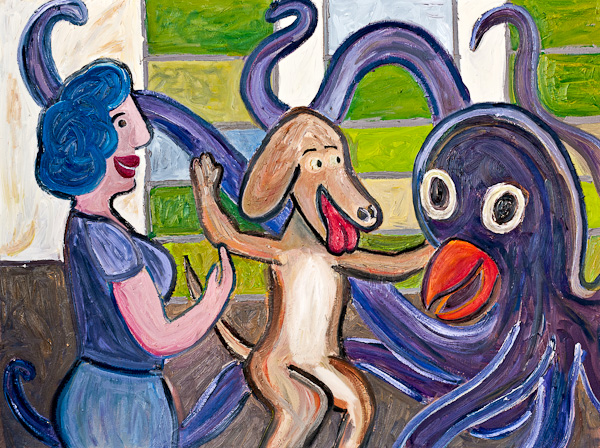
“Noon Meeting”, 40″ x 30″ inches, August, 2011, Oil on canvas.” Click for larger version.
Noon Meeting is one of those pictures that’s a bit like an unknown parable. I started out with a set of pebble-glass windows that I like, for the the background grid of green and yellow rectangles. I put three characters in front of the windows, happy to be getting together in the daytime: a woman, a dog, and an octopus. I feel like these three friends are people I know. Indeed, I might be the dog in the middle, bringing the two others together—I used to have a dog who looked a lot like that, his name was Arf. When I told my artist friend Vernon Head bout the theme of my new picture and he said, laughing, “Ah, yes, the three fundamental elements of any successful painting: a woman, a dog, and an octopus.” My other artist friend Paul Mavrides had suggested that I try using an impasto medium to build up more of a texture on my pictures and I did this here, with a nice effect.
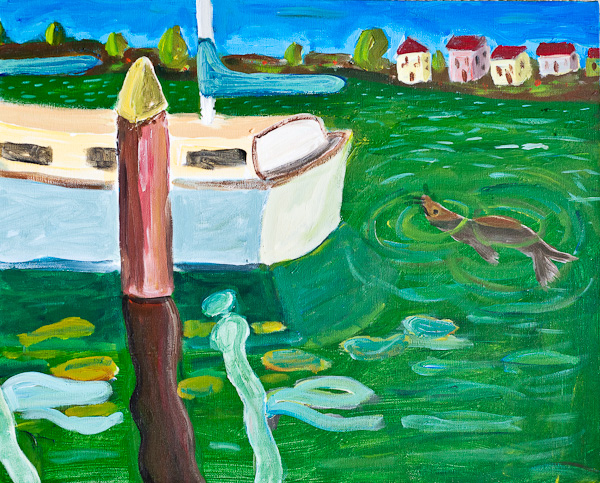
“Santa Cruz Harbor,” by Rudy Rucker, 20 x 16 inches, September, 2011, Acrylic on canvas. Click for a larger version of the picture.
My friend Vernon Head and I went to Santa Cruz Harbor for a painting session. The waters were fill of life—apparently a school of mackerel had swum in, and the pelicans and seals were there feeding. I liked how this cute baby seal seemed to hover so weightlessly in the very clear water. I started my Santa Cruz Harbor painting on the spot, and finished it at home, working with some photographs I’d taken. It had been awhile since I used acrylics, and I was pleasantly surprised by how quickly I was done.
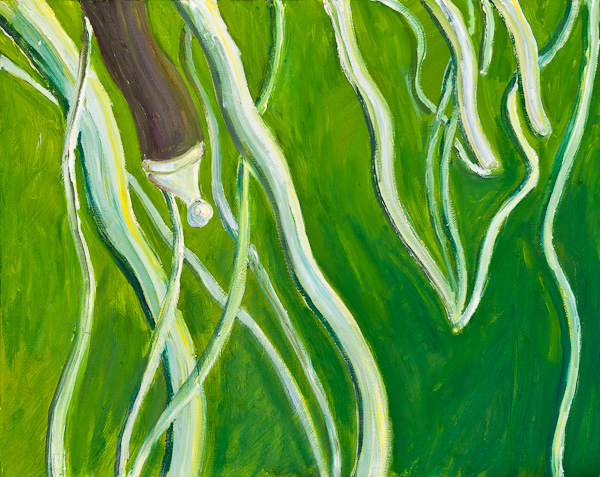
“Rigging,” by Rudy Rucker, 20 x 16 inches, September, 2011, Oil on canvas.” Click for a larger version of the picture.
The reflections of sailboat rigging fascinate me. I took some photos for my Rigging painting during the same session where I started Santa Cruz Harbor. Back home I copied one of the photos for an oil painting. I put on quite a few layers, and used a gel medium to emphasize the brush strokes on the masts and lines.
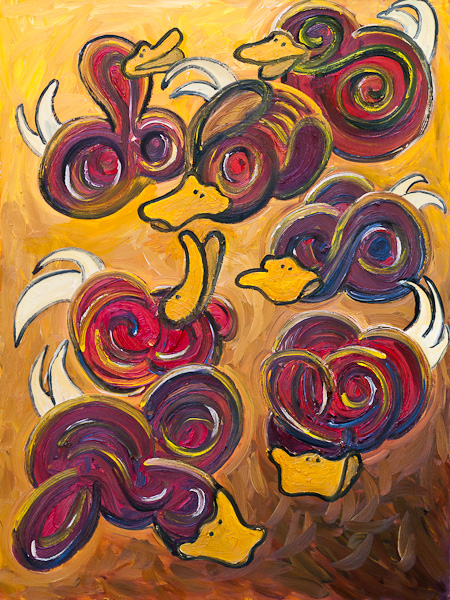
“Four-dimensional Ducks,” by Rudy Rucker, 30 x 40 inches, October, 2011, Oil on canvas. Click for a larger version of the picture.
I started Four-Dimensional Ducks as an abstract painting with seven globs. I made efforts to make the globs look different from each other, and to have intricate, three-dimensional forms. And then I started thinking of the globs as cross-sections of four-dimensional creatures. And then I realized they should be loosely based on the master cartoonist Carl Barks’s drawings of Donald Duck, as if they were rotating in and out of our space. Four-dimensional ducks. A way to move my pop surrealism style towards abstraction.
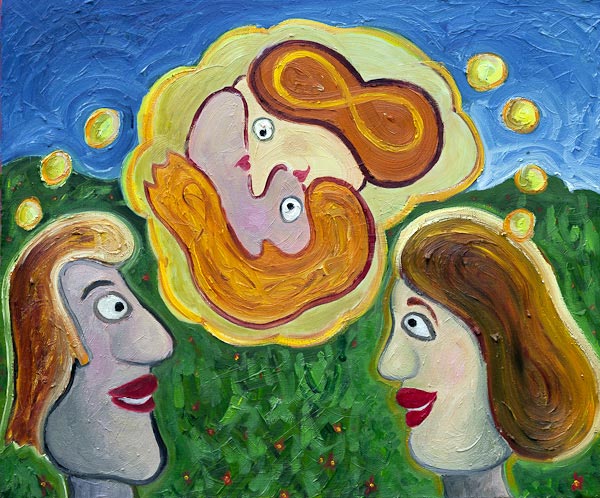
“The Lovers,” by Rudy Rucker, 24 x 20 inches, January, 2012, Oil on canvas. Click for a larger version of the picture.
The idea is that these two lovers are in a nearly telepathic state, sharing a single thought balloon. And in the thought, they’re merged like a yin-yang symbol. Her 1940s bob acquires an infinity symbol, and their lips form a pair of little hearts. An early Valentine’s Day picture!
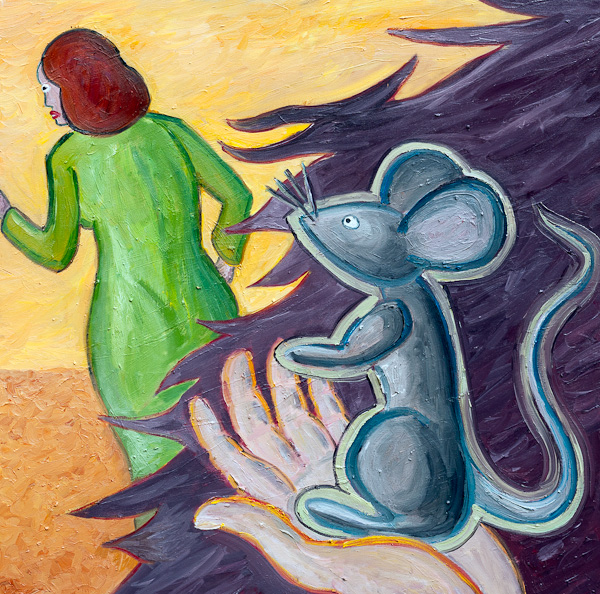
“Loulou and Skungy,” oil on canvas, February, 2012, 30” x 30”. Click for a larger version of the image.
In Skungy and the Rat, Loulou is the somewhat mysterious woman in green, Skungy is the rat, and the guy holding the rat is an artist named Zad Plant. The picture is like an illustration of an unknown proverb or a forgotten fable. When I painted it, I didn’t entirely know what’s going on. But I did have some ideas, as the picture was painted as a previsualization of a scene in the novel I was preparing to write—The Big Aha. The woman character, named Loulou, is luring Zad and his “qwet rat” Skungy into following her. The composition was inspired by a Joan Brown painting The End of the Affair.
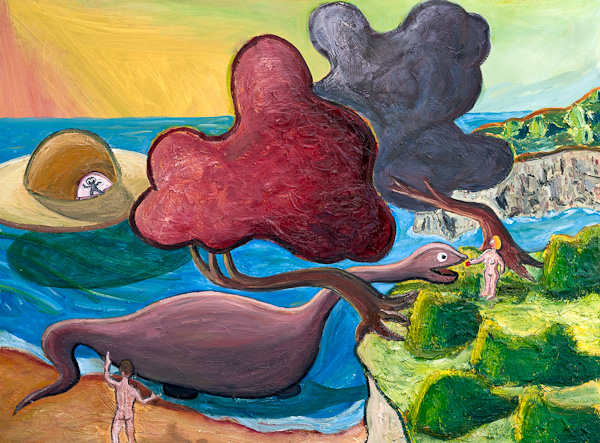
“Garden of Eden,” oil on canvas, May, 2012, 40” x 30”. Click for a larger version of the image.
My frequent partner in art, Vernon Head, went out for an en plein air painting session with me on the bank of a stream that runs into the south end of Lexington Reservoir near Los Gatos. It was a lovely spring day, and we daubed away. The one thing that caught my attention the most was a particular bend in the trunk of a tree overhanging the creek. That made it into my painting, Garden of Eden, but not all that much else about the actual scene. Instead I put in two of my favorite things: a dinosaur and a UFO. I’m not exactly sure what the scenario here is—perhaps the UFO is in some way bringing enlightenment to a prehistoric pair, an Adam and an Eve.
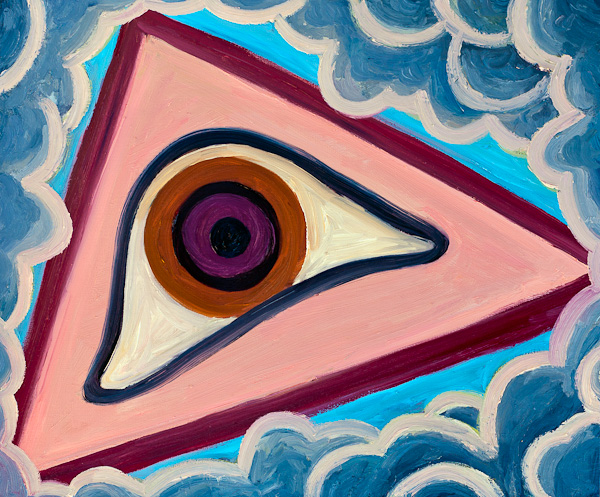
“God’s Eye,” oil on canvas, June, 2012, 24” x 20”. Click for a larger version of the image.
I’ve always been intrigued by a certain image that one sees in old European churches—an eye inside a triangle. This icon also appears, of course, on the dollar bill. It’s meant to represent the all-seeding eye of God or perhaps the divine Mind within every object. In researching me novels with Bruegel and Bosch as characters, I got the impression that medieval people really did think God was watching them. So in God’s Eye I’ve painted the eye as looking down through clouds—like a spy-satellite. I made the “skin” in this image pink as a kind of joke on the fact that God is sometimes visualized as an old white man.
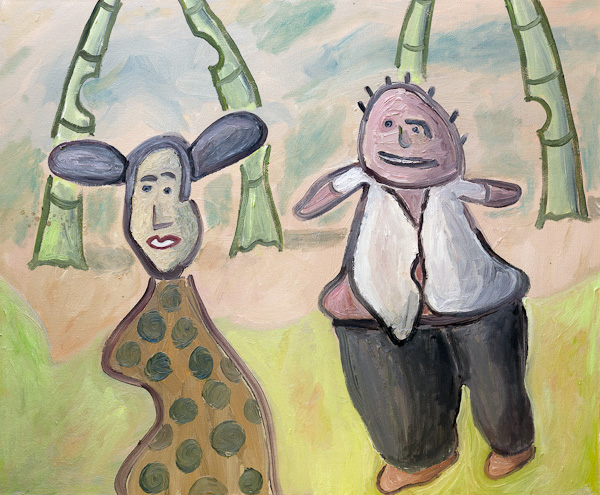
“Louisville Artist,” oil on canvas, October, 2012, 24” x 20”. Click for a larger version of the image.
I grew up in Louisville, Kentucky, so the title Louisville Artist is a bit of a parodistic self-image riff. In other words, that’s could be me on the right , shirt all untucked and with no fingers on my hands. The woman might be my muse. Another interpretation is that the two figures are characters from the novel, The Big Aha, which I’m presently working on when I made the painting. In making this picture, I thought it would be interesting to put in some figures that looked like children’s drawings, so I worked from a messy sketch I’d made. The colors are more pastel than usual for me, and there’s a bit of a Japanese quality.
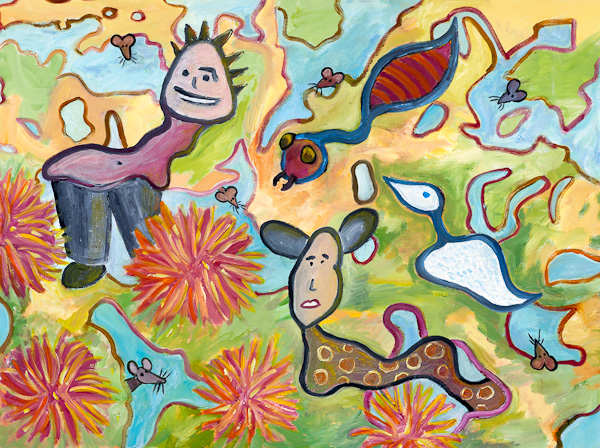
“Night of Telepathy,” oil on canvas, November, 2012, 40” x 30”. Click for a larger version of the image.
Night of Telepathy started out with the abstract background pattern, which I made using leftover paint from Louisville Artist. I decided to put in some figures in, and I thought I’d like to reuse the Louisville Artist figures. In my novel in progress, The Big Aha, my two characters Zad and Loulou had just spent a night in bed in in telepathic contact with each other. And I wanted to give an impression of an odd, dreamy night. The six little rats correspond to some subdimensional creatures that might be scuttling around inside people’s dreams. And the other creatures are just there for fun.
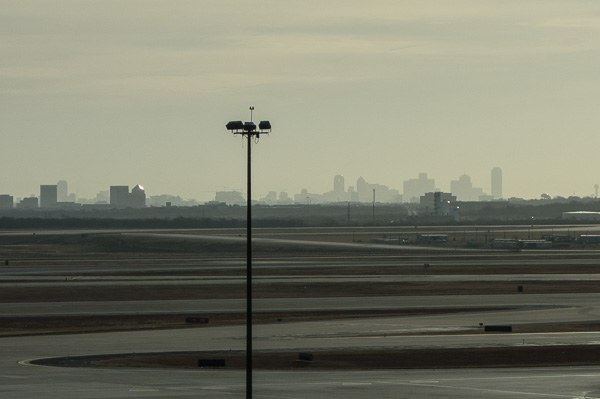
So…make the trek to the mirage-like realm of Borderlands Books at 866 Valencia St. in San Francisco.
And, as I already said, I’ll be hanging a show of my paintings in the Borderlands Books café with a reception on Friday, Jan 11, 5-7 pm. And I’ll give a reading and Q&A session for my novel Turing & Burroughs: A Beatnik SF Novel on Saturday, Jan 12, at 3 pm. Hope to see you there.
